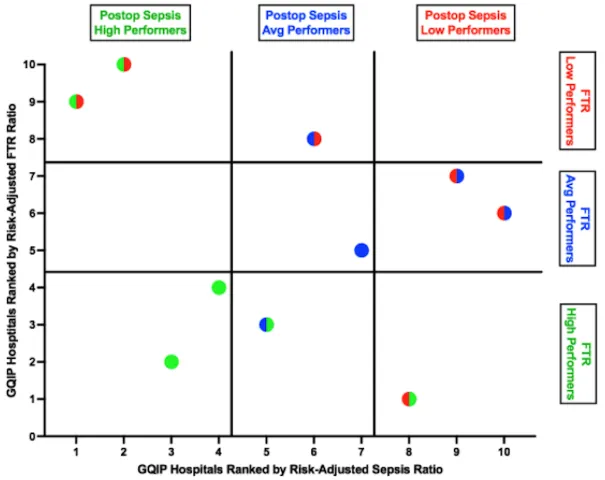Monitoring Prevention and Rescue for Postoperative Sepsis Performance Measurement in a Statewide Surgical Collaborative
Author(s):
Jessie Codner; Eli Mlaver; Gina Solomon; Muhammad Saeed; Mengyu Di; Virginia Shaffer; Chris Dente; John Sweeney; Rachel Patzer; Jyotirmay Sharma
Background:
The Georgia Quality Improvement Program (GQIP) surgical collaborative has shown poor performance in postoperative sepsis compared to national benchmarks in NSQIP. Reporting quality metrics in a collaborative setting facilitates best practice dissemination.
Hypothesis:
We aimed to expand postoperative sepsis performance measurement by evaluating additional quality metrics along the surgical care pathway, providing a new perspective of risk-adjusted postoperative sepsis rates by also calculating sepsis prevention and mortality rescue for GQIP hospitals.
Methods:
The cohort included intra-abdominal general surgery patients across ten GQIP hospitals from 2015-2020. ACS-NSQIP data were utilized to train and validate a multivariable model with postoperative sepsis as the outcome. This model was used to rank hospitals by risk-adjusted postoperative sepsis rates. Failure to prevent (FTP) was calculated by dividing postoperative sepsis occurrences by postoperative infectious complications. Failure to rescue (FTR) was defined as mortality after postoperative sepsis. Crude and risk-adjusted FTR were calculated. Complication management quality metrics were compared to risk-adjusted postoperative sepsis rankings.
Results:
The study included 20,314 patients with 595 cases of postoperative sepsis. FTP rates trended upward and correlated with risk-adjusted sepsis rankings. Crude and risk-adjusted FTR did not correlate with sepsis prevention or risk-adjusted postoperative sepsis rankings. After adjusting FTR for demographics, comorbidities, and elements of preoperative care, 5 out of 10 hospitals were re-ranked; and 3 hospitals changed tertile ranking between crude and risk adjusted FTR rankings.

Conclusions:
Postoperative sepsis complication management quality metrics are important to present in collaborative settings. They do not always correlate, as they provide insight into different aspects of surgical care. Each should be considered for benchmarking to guide precise targets for quality improvement.
